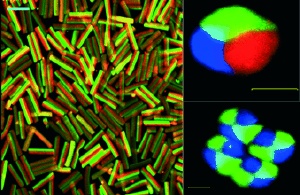May 25 2009
Under a microscope they look like tiny pie charts or colorful candy canes: A team led by Joerg Lahann at the University of Michigan (USA) has been able to produce micrometer-wide discs and elongated rods precisely built out of multicolored compartments. As reported in the journal Angewandte Chemie, these scientists have developed a simple, cost-effective, reliable, and scalable method for the production of microcylinders with multiple compartments. The inner structure, aspect ratio, and surface chemistry can be tuned by means of the new production method which is based on electrodynamic co-spinning and microcutting processes.
 © Wiley-VCH
© Wiley-VCH
Bicolor cylinders were made by pumping two differently colored biodegradable polymer solutions through two side-by-side jets. An electrical field stretches the exiting drops, resulting in a bicompartmental fiber that is “spun” into a bundle of parallel individual fibers. The researchers embed the 1 cm long fiber bundles in a gel, which they then freeze. Using a microtome, they slice off thin sections. Upon dissolution of the gel in water and treatment with ultrasound, the bundles can be separated into individual cylinders of uniform size. The length of the cylinders depends on the thickness of the microtome sections, which allows for the production of everything from flat discs to long rods.
If more than two jets are used, it is possible to make fibers out of three, four, or more different components. Depending on the arrangement of the jets, different patterns can be generated. For example, it is possible to fabricate cylindrical particles that look like a three-section or four-section pie chart. If the jets are positioned next to each other, the result is a striped structure. The individual segments are always identical in size and are clearly delineated.
Instead of dyeing the components, it is also possible to attach various (bio-)reagents to the segments of the cylinders if specific “anchor sites” are built into the polymer. Special shapes can also be produced when one or more segments are made of a polymer that can be selectively dissolved. For example, one fourth of a four-component cylinder can be removed to make a rod with a groove.
The new method can be used to produce particles made of precisely designed compartments with mutually independent physical and chemical properties. Possible areas of application include drug transport, tissue culture, and bundled biotests, as well as “intelligent displays” and reactive materials.